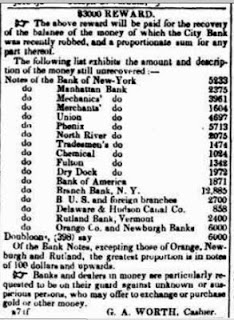
PREV ARTICLE
NEXT ARTICLE
FULL ISSUE
PREV FULL ISSUE
NEW YORK'S FIRST BANK ROBBERY
This week I came across a blog article on New York's first bank robbery. What was most interesting to me was the description of the
1831 haul, which included both bank notes and Spanish doubloons. Ads run afterwards by the bank detail the issuers of the banknotes.
Together, these provide a view into the money circulating in the country at that time. -Editor
Though suspicion immediately fell on workers at the bank, the police had little time to investigate the employees before they received a tip from Mr. Bangs, the proprietor of a “respectable private boarding house” (according to the New-York Evening Post) who was leery of his newest tenant. On the Monday following the robbery, a man calling himself Mr. Jones had arrived at Mr. Bangs's boarding house on Elm Street with three small trunks, asking for a private room in which to write. He paid for the room in advance. After a few days, the landlord became suspicious over Mr. Jones’s apparent anxiety, especially concerning the contents of his trunks. When one of the trunks disappeared, Mr. Bangs contacted the police. The police—seemingly without probable cause or a warrant—picked the locks of the two remaining trunks and found bank notes they could positively identify as being from the City Bank robbery. When Mr. Jones returned to the boarding house, he was promptly arrested. The robber was soon discovered to be Edward Smith, who lived on Division Street with his wife and two children and ran a shoe store. He was well-known to police, having been arrested for a store robbery in Brooklyn. Of the $245, 000, only about $176,000 was recovered from Smith. The bank soon began advertising for people to keep an eye out for the other bank notes (and the Spanish doubloons). One apparent accomplice was arrested in Philadelphia in April when some of the missing bank notes were identified on his person. But it is unclear if the remainder of the money was ever recovered or if that man was, indeed, part of the robbery. A jury found Edward Smith guilty in a one-day trial (that one day included jury selection, testimony, and deliberations) and he was sentenced to five years hard labor in Sing-Sing prison.
Is the blog author correct in calling this New York's FIRST bank robbery? 1831 seems late - banks had been around in this country for
decades. Does anyone know of an earlier New York robbery? Or the earliest one in the country? -Editor
To read the complete article, see:
Wayne Homren, Editor The Numismatic Bibliomania Society is a non-profit organization promoting numismatic literature. See our web site at coinbooks.org. To submit items for publication in The E-Sylum, write to the Editor at this address: whomren@gmail.com To subscribe go to: https://my.binhost.com/lists/listinfo/esylum All Rights Reserved. NBS Home Page Contact the NBS webmaster 
|
